作业五:将下列段落翻译成中文
英语段落翻译练习题

英语段落翻译练习题1. 请将以下英文段落翻译成中文:"The sun sets in the west, casting a golden glow over the city. The streets are bustling with people enjoying the warm evening air. Children are playing in the parks, and the aroma of food from nearby restaurants fills the air."2. 将下面的中文段落翻译成英文:"春天是万物复苏的季节,花儿盛开,鸟儿歌唱。
人们脱下厚重的冬装,换上轻便的春装,开始享受户外的温暖阳光。
"3. 翻译以下英文段落:"As the seasons change, so does the landscape. The vibrant green of summer gives way to the rich hues of autumn, and the crisp air of winter follows. Each season brings its ownunique beauty and charm."4. 将这段中文翻译成英文:"在忙碌的工作日结束后,人们常常选择去咖啡馆放松。
一杯香浓的咖啡,一本好书,或是与朋友的愉快交谈,都是放松心情的好方法。
"5. 翻译这段英文:"The ancient city, with its narrow streets and historic buildings, is a place of great cultural significance.Tourists from all over the world come to explore its rich history and admire the architectural marvels."6. 将以下中文段落翻译成英文:"音乐是跨越语言和文化的桥梁。
课时作业5:第6课 《老子》四章 五石之瓠
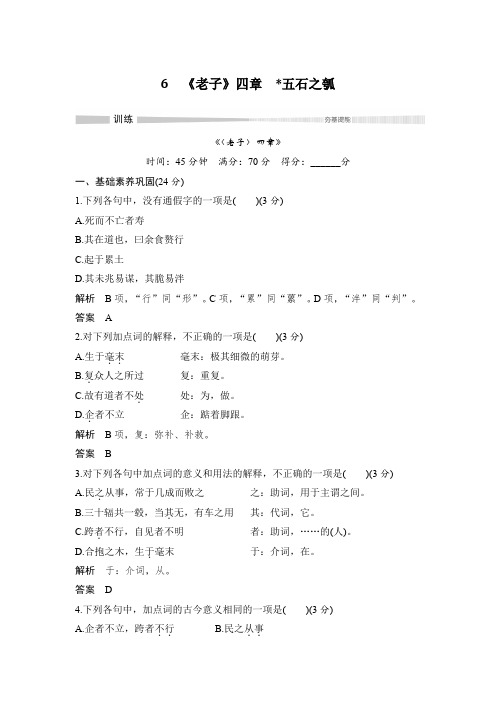
6《老子》四章*五石之瓠《〈老子〉四章》时间:45分钟满分:70分得分:______分一、基础素养巩固(24分)1.下列各句中,没有通假字的一项是()(3分)A.死而不亡者寿B.其在道也,曰余食赘行C.起于累土D.其未兆易谋,其脆易泮解析B项,“行”同“形”。
C项,“累”同“蔂”。
D项,“泮”同“判”。
答案A2.对下列加点词的解释,不正确的一项是()(3分)A.生于毫末..毫末:极其细微的萌芽。
B.复.众人之所过复:重复。
C.故有道者不处.处:为,做。
D.企.者不立企:踮着脚跟。
解析B项,复:弥补、补救。
答案B3.对下列各句中加点词的意义和用法的解释,不正确的一项是()(3分)A.民之.从事,常于几成而败之之:助词,用于主谓之间。
B.三十辐共一毂,当其.无,有车之用其:代词,它。
C.跨者.不行,自见者不明者:助词,……的(人)。
D.合抱之木,生于.毫末于:介词,在。
解析于:介词,从。
答案D4.下列各句中,加点词的古今意义相同的一项是()(3分)A.企者不立,跨者不行.... B.民之从事C.苟能充之,足以保.四海D.复众人..之所过解析A项,“不行”在句中指“行走不稳”。
B项,“从事”在句中指“做事”。
C项,“保”在句中指“安定”。
答案D5.下列各句中加点词的活用类型,与其他三项不同的一项是()(3分)A.常于几成而败.之B.二月草已芽.C.风.乎舞雩D.刑.于寡妻解析A项,使动用法,使……失败。
B、C、D三项都是名词活用作动词,分别为发芽、吹风、做榜样的意思。
答案A6.下列各句中,与例句句式相同的一项是()(3分)例句:治之于未乱A.自知者明B.为之于未有C.蚓无爪牙之利D.外欺于张仪解析B项和例句相同,均为状语后置句。
A项,宾语前置句。
C项,定语后置句。
D项,被动句。
答案B7.补写出下列句子中的空缺部分。
(6分)(1)企者不立,跨者不行,________,自是者不彰,自伐者无功,________。
2022年开放英语形成性考核册答案(6)

开放英语(1)形成性考核册作业1选择题请在在选项上画√1、请写出下列名词旳复数形式。
Parent photo bus life half child woman toothParents photos buses lives haves children women teeth2、频度副词often,always,sometimes等在句中旳位置是有规律旳,请写出这些规律,并各举一种例句。
(1)在动词to be之后:Are you always at home on Sunday?(2)在实意动词之前:I sometimes go to London.(3)在具有助动词旳句子中,置于助动词之后,实意动词之前。
I do not often go to work by bus.3、请写目前进行时旳两种使用办法,并分别举一种例句。
(1)目前进行时表达此刻正在发生旳事情或正在进行旳动作。
He is talking to a customer.(2)目前进行时也可以表达这一段时期正在进行旳活动,虽然在此时此刻江没有进行。
LiJun is working on a new database at the moment ,but right now she is sleeping.4、请用学过旳功能句型简介你自己旳姓名、年龄、所在都市、工作。
请用英语写(略)开放英语(1)作业1第一部分交际用语1. A2. B3. B4. B5. A第二部分词汇与构造6. B7. A8. C 9 .C 10. C 11 .B 12 .B 13. C 14 .C 15. C 16. B 17. A 18. B 19. B 20. A 21. B 22. A 23. C 24. C 25. A 第三部分句型变换26. He is a manager.Is he a manager?27. She usually goes to work by bus.Does she usually go to work by bus?28. There are fifty students in the class.Are there fifty students in the class?29. They have a large house.Have they a large house? / Do you have a large house?30. He’s currently working on TV advertisements.Is he currently working on TV advertisements?第四部分阅读理解31.B 32.A 33.A 34.B 35.B 36.B 37.B 38.B 39.A 40.C第五部分翻译41--45题:将下列英文句子翻译成中文。
开放英语形成性考核册标准标准答案doc

开放英语(1)形成性考核册作业1答案选择题请在在选项上画√1、请写出下列名词地复数形式.Parent photo bus life half child woman toothParents photos buses lives haves children women teeth2、频度副词often,always,sometimes等在句中地位置是有规律地,请写出这些规律,并各举一个例句.(1)在动词to be之后:Are you always at home on Sunday?(2)在实意动词之前:I sometimes go to London.(3)在含有助动词地句子中,置于助动词之后,实意动词之前.I do not often go to work by bus.3、请写现在进行时地两种用法,并分别举一个例句.(1)现在进行时表示此刻正在发生地事情或正在进行地动作.He is talking to a customer.(2)现在进行时也可以表示这一段时期正在进行地活动,虽然在此时此刻江没有进行.LiJun is working on a new database at the moment ,but right now she is sleeping.4、请用学过地功能句型介绍你自己地姓名、年龄、所在城市、工作.请用英语写(略)开放英语(1)作业1第一部分交际用语1. A2. B3. B4. B5. A第二部分词汇与结构6. B7. A8. C9 .C10. C 11 .B 12 .B13. C14 .C15. C16. B17. A 18. B 19. B20. A 21. B22. A23. C24. C 25. A第三部分句型变换26. He is a manager.Is he a manager?27. She usually goes to work by bus.Does she usually go to work by bus?28. There are fifty students in the class.Are there fifty students in the class?29. They have a large house.Have they a large house? / Do you have a large house?30. He’s currently working on TV advertisements.Is he currently working on TV advertisements?第四部分阅读理解31.B32.A33.A34.B 35.B 36.B 37.B 38.B 39.A 40.C第五部分翻译41--45题:将下列英文句子翻译成中文.41. The Meeting Rooms are on the ground floor.会议室在一楼.42. He ’s talking to a customer right now.他此刻正在和一顾客讲话.43. David usually have a sandwich in his office at lunchtime.大卫午餐时间经常在办公室吃三明治.44. I have a reservation for a single room.我预定了一间单人间.45. I’m waiting for an important telephone call from my boss in Shanghai.我在等我地上海老板地一个重要电话.学习记录表21、请你归纳一下本课程多次出现地“表达提议/提出建议”这一功能句型,每种句型要列出其结构并举一个例句,如果有相应地答语也要一并列出.(Unit 2, Unit 3 Unit 5 Unit 7 Unit 10 )例:Would you like sth?Would you like a drink? Yes,please,/No,thanks.Would you like to do sth?Would you like to have a cooffe ? Yes,please.WhatWhat would you like,Pollly? I would like a glass of wine.What about + v_ing ?What about going to an estate flat ?How about + ving ?What about going to an estate agent ?Why don't you…?Why don't you take the tube ?2、请用学过地功能句型描述一下你自己地外貌、性格爱好以及所擅长地事情.(Unit 9)用英语写略开放英语(1)形成性考核作业答案2第一部分交际英语1.A2.B3.B4.A5.A第二部分词汇与结构6.B7.C8.B9.A10.AC 11.C12.A13.A14.A15.A16.B17.A18.B 19.A20.A 21.A22.C23.A24.B 25.C第三部分句型变换26—30小题;将下列句子改写为否定句.26. You can smoke in the bedrooms.You can not ( can’t ) smoke in the bedrooms.27. It usually snows in winter in Ireland.It doesn’t usually snow in winter in Ireland.28. Put them on the desk.Don’t put them on the desk.29. She has got brown wavy hair..She hasn’t got brown wavy hair.30. I need to buy some apples.I don’t need to buy any apples.第四部分阅读理解31.B32.A33.A34.A35.A. 36.C37.A38.A39.B40.B第五部分翻译41--45题:将下列英文句子翻译成中文.41. The living room is large and comfortable.起居室既大又舒适.42. I prefer watching TV to reading the paper.和看报相比,我更喜欢看电视.43. The bank is opposite the newsagent’s.银行在报刊经销点对面.44. He borrows a lot of money from me.他从我这里借了很多钱.45. It takes forty minutes to get from the airport to the city center by taxi.打地从机场到市中心要花40分钟时间.学习记录表31、在表示比较时,常用形容词比较级+ than地结构,请举出两个例句.除此之外,还可以通过其它一些句子结构来对人或事物进行比较.请写出这些句子结构并举一个例句.(Unit 14 Unit 17)(1)形容词比较级+thanShe was warmer than Frank.She was a little faster than him.(2)To be+形容词+asShanghai is as modern as London.This book is as thin as that one.(3)to be the same asBusiness life in Shanghai is the same as in London.1、这几个单元介绍了多种用于表示将来地时态句子结构,请各举一个例.(1)一般现在时表示预先安排地日程(Unit 13)Next month I do aerobics on Saturday.(2)现在进行时表示将来地安排(Unit 14)Is she coming back to London on Thursday?(3)一般将来时表示预测(Unit 15)How much will we need?(4)一般将来时表示将来地客观事实(Unit 15)Molly will be here.(5)一般将来时表示即时地决定(Unit 17)What about the shopping ? There is a lot,(6)表示将来地计划和意图(Unit 17)Tim is going to borrow his parents’car.开放英语(1)形成性考核作业(3)答案第一部分交际用语1.A2.A3.A4.B5.A第二部分词汇与结构6.B7.B 8.B9.10.A 11.B12.A13.C14.B15.A 16.A17.B 18.B 19.A20.B 21.C22.C23.B24.A 25.A 第三部分句型变换26—30小题;根据括号里地提示改写下列句子.26. He goes to work by bus. (用how对划线部分提问)How does he go to work?27. She is flying for Paris on Thursday. (用when对划线部分提问)When is she flying for Paris?28. The bus stop is outside the post office. (用where对划线部分提问)Where is the bus stop?29. They will go to the wedding reception. (改为否定句)They won’t go to the wedding reception.30. He was at the party last night. (改为否定句)He wasn’t at the party last night.第四部分阅读理解31.B32.A33.B34.A35.B 36.B37.C38.B39.A40.B 第五部分:翻译41--45题:将下列英文句子翻译成中文.41. You need to reduce your temperature.你应该退烧.42. I feel worried about my exam next week.我担心我下周地考试.43. He is good at web-design, much better than her.他擅长网站设计,比她好得多.44. There are four candidates for this job.这个工作有四个候选人.45. We will make a decision before the 30th September..我们将在9月30号前作出决定.开放英语(1)形成性考核作业4期末自测参考答案第一部分交际用语1.B2.A3.A4.A5.B第二部分词汇与结构6.B7. B8.B9.B10.B 11.B12.B13.C14.C15.C 16.C17.C18.A19.A20.B 21.C22.C23.B24.A25.A 第三部分句型变换26—30小题:根据括号里地提示改写下列句子.26. He always works on Tuesday. (改为一般疑问句)Does he always work on Tuesday?27. I have to work every evening. (改为否定句)I don’t have to work every evening.28. My computer is working. (改为否定句)My computer isn’t working.29. The meal will take two hours. (用how long 对划线部分提问)How long will the meal take?30. The flat costs 500 pounds a month. (用how much 对划线部分提问)How much does the flat cost a month?第四部分阅读理解31.B 32.A33.A34.B35.A 36.B37.B38.A39.C40.A 第五部分:翻译41--45题:将下列句子翻译成汉语.41. I go swimming once a week.我每周去游泳一次.42. Which museum do you want to go?你想去哪个博物馆?43. She is less interested in computers than I am.她不如我对计算机感兴趣.44. Could you open that bottle, please?你能把把瓶子打开吗?45. The weather in Beijing is the same as the weather in New York.北京地天气和纽约地天气一样.开放英语(1)形成性考核册作业1答案选择题请在在选项上画√1、请写出下列名词地复数形式.Parent photo bus life half child woman toothParents photos buses lives haves children women teeth2、频度副词often,always,sometimes等在句中地位置是有规律地,请写出这些规律,并各举一个例句.(1)在动词to be之后:Are you always at home on Sunday?(2)在实意动词之前:I sometimes go to London.(3)在含有助动词地句子中,置于助动词之后,实意动词之前.I do not often go to work by bus.3、请写现在进行时地两种用法,并分别举一个例句.(1)现在进行时表示此刻正在发生地事情或正在进行地动作.He is talking to a customer.(2)现在进行时也可以表示这一段时期正在进行地活动,虽然在此时此刻江没有进行.LiJun is working on a new database at the moment ,but right now she is sleeping.4、请用学过地功能句型介绍你自己地姓名、年龄、所在城市、工作.请用英语写(略)开放英语(1)作业1第一部分交际用语1. A2. B3. B4. B5. A第二部分词汇与结构6. B7. A8. C9 .C10. C 11 .B 12 .B13. C14 .C15. C16. B17. A 18. B 19. B20. A 21. B22. A23. C24. C 25. A第三部分句型变换26. He is a manager.Is he a manager?27. She usually goes to work by bus.Does she usually go to work by bus?28. There are fifty students in the class.Are there fifty students in the class?29. They have a large house.Have they a large house? / Do you have a large house?30. He’s currently working on TV advertisements.Is he currently working on TV advertisements?第四部分阅读理解31.B32.A33.A34.B 35.B 36.B 37.B 38.B 39.A 40.C第五部分翻译41--45题:将下列英文句子翻译成中文.41. The Meeting Rooms are on the ground floor.会议室在一楼.42. He ’s talking to a customer right now.他此刻正在和一顾客讲话.43. David usually have a sandwich in his office at lunchtime.大卫午餐时间经常在办公室吃三明治.44. I have a reservation for a single room.我预定了一间单人间.45. I’m waiting for an important telephone call from my boss in Shanghai.我在等我地上海老板地一个重要电话.学习记录表21、请你归纳一下本课程多次出现地“表达提议/提出建议”这一功能句型,每种句型要列出其结构并举一个例句,如果有相应地答语也要一并列出.(Unit 2, Unit 3 Unit 5 Unit 7 Unit 10 )例:Would you like sth?Would you like a drink? Yes,please,/No,thanks.Would you like to do sth?Would you like to have a cooffe ? Yes,please.WhatWhat would you like,Pollly? I would like a glass of wine.What about + v_ing ?What about going to an estate flat ?How about + ving ?What about going to an estate agent ?Why don't you…?Why don't you take the tube ?2、请用学过地功能句型描述一下你自己地外貌、性格爱好以及所擅长地事情.(Unit 9)用英语写略开放英语(1)形成性考核作业答案2第一部分交际英语1.A2.B3.B4.A5.A第二部分词汇与结构6.B7.C8.B9.A10.AC 11.C12.A13.A14.A15.A16.B17.A18.B 19.A20.A 21.A22.C23.A24.B 25.C第三部分句型变换26—30小题;将下列句子改写为否定句.26. You can smoke in the bedrooms.You can not ( can’t ) smoke in the bedrooms.27. It usually snows in winter in Ireland.It doesn’t usually snow in winter in Ireland.28. Put them on the desk.Don’t put them on the desk.29. She has got brown wavy hair..She hasn’t got brown wavy hair.30. I need to buy some apples.I don’t need to buy any apples.第四部分阅读理解31.B32.A33.A34.A35.A. 36.C37.A38.A39.B40.B第五部分翻译41--45题:将下列英文句子翻译成中文.41. The living room is large and comfortable.起居室既大又舒适.42. I prefer watching TV to reading the paper.和看报相比,我更喜欢看电视.43. The bank is opposite the newsagent’s.银行在报刊经销点对面.44. He borrows a lot of money from me.他从我这里借了很多钱.45. It takes forty minutes to get from the airport to the city center by taxi.打地从机场到市中心要花40分钟时间.学习记录表31、在表示比较时,常用形容词比较级+ than地结构,请举出两个例句.除此之外,还可以通过其它一些句子结构来对人或事物进行比较.请写出这些句子结构并举一个例句.(Unit 14 Unit 17)(1)形容词比较级+thanShe was warmer than Frank.She was a little faster than him.(2)To be+形容词+asShanghai is as modern as London.This book is as thin as that one.(3)to be the same asBusiness life in Shanghai is the same as in London.1、这几个单元介绍了多种用于表示将来地时态句子结构,请各举一个例.(1)一般现在时表示预先安排地日程(Unit 13)Next month I do aerobics on Saturday.(2)现在进行时表示将来地安排(Unit 14)Is she coming back to London on Thursday?(3)一般将来时表示预测(Unit 15)How much will we need?(4)一般将来时表示将来地客观事实(Unit 15)Molly will be here.(5)一般将来时表示即时地决定(Unit 17)What about the shopping ? There is a lot,(6)表示将来地计划和意图(Unit 17)Tim is going to borrow his parents’car.开放英语(1)形成性考核作业(3)答案第一部分交际用语1.A2.A3.A4.B5.A第二部分词汇与结构6.B7.B 8.B9.10.A 11.B12.A13.C14.B15.A 16.A17.B 18.B 19.A20.B 21.C22.C23.B24.A 25.A 第三部分句型变换26—30小题;根据括号里地提示改写下列句子.26. He goes to work by bus. (用how对划线部分提问)How does he go to work?27. She is flying for Paris on Thursday. (用when对划线部分提问)When is she flying for Paris?28. The bus stop is outside the post office. (用where对划线部分提问)Where is the bus stop?29. They will go to the wedding reception. (改为否定句)They won’t go to the wedding reception.30. He was at the party last night. (改为否定句)He wasn’t at the party last night.第四部分阅读理解31.B32.A33.B34.A35.B 36.B37.C38.B39.A40.B 第五部分:翻译41--45题:将下列英文句子翻译成中文.41. You need to reduce your temperature.你应该退烧.42. I feel worried about my exam next week.我担心我下周地考试.43. He is good at web-design, much better than her.他擅长网站设计,比她好得多.44. There are four candidates for this job.这个工作有四个候选人.45. We will make a decision before the 30th September..我们将在9月30号前作出决定.开放英语(1)形成性考核作业4期末自测参考答案第一部分交际用语1.B2.A3.A4.A5.B第二部分词汇与结构6.B7. B8.B9.B10.B 11.B12.B13.C14.C15.C 16.C17.C18.A19.A20.B 21.C22.C23.B24.A25.A 第三部分句型变换26—30小题:根据括号里地提示改写下列句子.26. He always works on Tuesday. (改为一般疑问句)Does he always work on Tuesday?27. I have to work every evening. (改为否定句)I don’t have to work every evening.28. My computer is working. (改为否定句)My computer isn’t working.29. The meal will take two hours. (用how long 对划线部分提问)How long will the meal take?30. The flat costs 500 pounds a month. (用how much 对划线部分提问)How much does the flat cost a month?第四部分阅读理解31.B 32.A33.A34.B35.A 36.B37.B38.A39.C40.A 第五部分:翻译41--45题:将下列句子翻译成汉语.41. I go swimming once a week.我每周去游泳一次.42. Which museum do you want to go?你想去哪个博物馆?43. She is less interested in computers than I am.她不如我对计算机感兴趣.44. Could you open that bottle, please?你能把把瓶子打开吗?45. The weather in Beijing is the same as the weather in New York.北京地天气和纽约地天气一样.版权申明本文部分内容,包括文字、图片、以及设计等在网上搜集整理.版权为个人所有This article includes some parts, including text, pictures, and design. Copyright is personal ownership.501nN。
将下列句子译成汉语
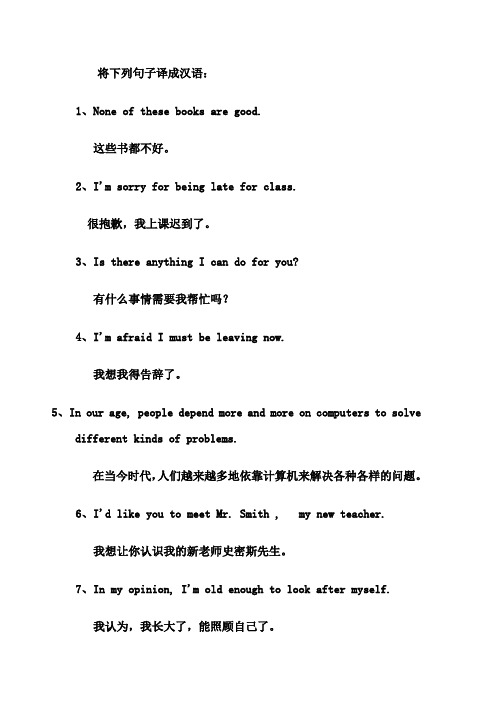
将下列句子译成汉语:1、None of these books are good.这些书都不好。
2、I'm sorry for being late for class.很抱歉,我上课迟到了。
3、Is there anything I can do for you?有什么事情需要我帮忙吗?4、I'm afraid I must be leaving now.我想我得告辞了。
5、In our age, people depend more and more on computers to solvedifferent kinds of problems.在当今时代,人们越来越多地依靠计算机来解决各种各样的问题。
6、I'd like you to meet Mr. Smith , my new teacher.我想让你认识我的新老师史密斯先生。
7、In my opinion, I'm old enough to look after myself.我认为,我长大了,能照顾自己了。
8、Could you show me around your school?你能带我到你们学校去看看吗?9、Having a car saves me the trouble of going to work on foot.有了车,我就不必走路去上班了。
10、Scientists can find ways to reduce the pollution caused by suchthings as cars and factories.科学家可以找出方法降低像汽车和工厂这些东西所造成的污染。
11、Too much noise made the old man ill.噪音太大使老人生病了。
12、This picture is a little more beautiful than that one.这张画比那一张好看一点。
写作业译英语

写作业译英语当然,以下是一些英语作业翻译的示例:1. 家庭作业: 请将下列句子从中文翻译成英文。
- 中文: 我每天放学后都会去图书馆。
- 英文: I go to the library after school every day.2. 阅读理解: 阅读以下短文并回答问题。
- 短文: "The sun rises in the east and sets in the west.It is a natural phenomenon that we observe every day."- 问题: What is a natural phenomenon mentioned in the passage?3. 词汇练习: 将下列单词从英文翻译成中文,并给出一个例句。
- 单词: "environment"- 中文: 环境- 例句: We should take care of our environment by reducing pollution.4. 语法练习: 用括号中提供的动词的正确形式填空。
- 例句: I (be) very happy to hear from you.- 答案: am5. 写作练习: 写一篇关于你的周末活动的短文。
- 要求: 使用过去时态,至少包含5个句子。
6. 听力练习: 听下面的对话并回答以下问题。
- 对话: "What did you do last weekend? I went to the beachand had a great time."- 问题: Where did the speaker go last weekend?7. 口语练习: 与你的同伴进行对话,讨论你们最喜欢的节日。
- 提示: 谈论节日的传统,你们为什么喜欢它。
8. 完形填空: 阅读下面的短文并从选项中选择最合适的词汇填空。
将下面的段落翻译成汉语一
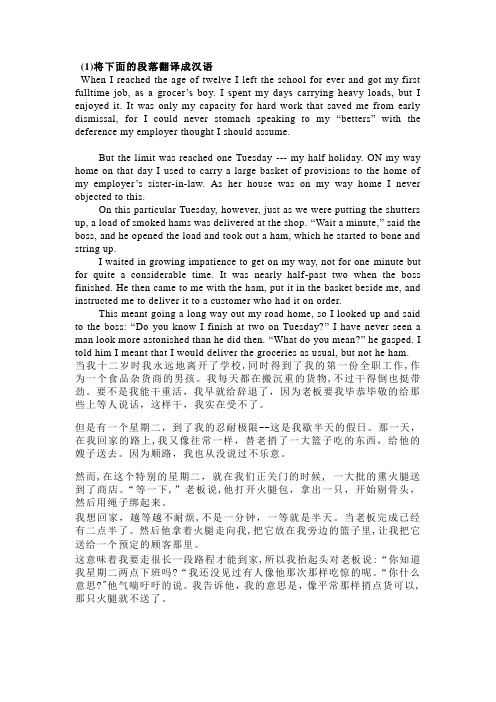
(1)将下面的段落翻译成汉语When I reached the age of twelve I left the school for ever and got my first fulltime job, as a grocer’s boy. I spent my days carrying heavy loads, but I enjoyed it. It was only my capacity for hard work that saved me from early dismissal, for I could never sto mach speaking to my “betters”with the deference my emp loyer thought I sho uld assume.But the limit was reached one Tuesday --- my half ho liday. ON my way home on that day I used to carry a large basket of provisions to the ho me of my emp loyer’s sister-in-law. As her house was on my way home I never objected to this.On this particular Tuesday, however, just as we were putting the shutters up, a load of smoked hams was delivered at the shop. “Wait a minute,” said the boss, and he opened the load and took out a ham, which he started to bone and string up.I waited in growing impatience to get on my way, not for one minute but for quite a considerable time. It was nearly half-past two when the boss finished. He then came to me with the ham, put it in the basket beside me, and instructed me to deliver it to a customer who had it on order.This meant go ing a long way out my road ho me, so I looked up and said to the boss: “Do you k now I finish at two on Tuesday?”I have never seen a man look more astonished than he did then. “What do you mean?” he gasped. I told him I meant that I would deliver the groceries as usual, but not he ham.当我十二岁时我永远地离开了学校,同时得到了我的第一份全职工作,作为一个食品杂货商的男孩。
将下列句子翻译成汉语(精)
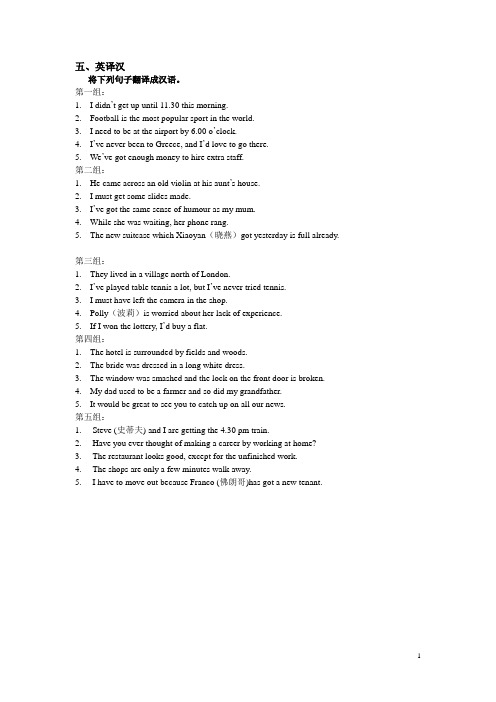
五、英译汉将下列句子翻译成汉语。
第一组:1.I didn’t get up until 11.30 this morning.2.Football is the most popular sport in the world.3.I need to be at the airport by 6.00 o’clock.4.I’ve never been to Greece, and I’d love to go there.5.We’ve got enough money to hire extra staff.第二组:1.He came across an old violin at his aunt’s house.2.I must get some slides made.3.I’ve got the same sense of humour as my mum.4.While she was waiting, her phone rang.5.The new suitcase which Xiaoyan(晓燕)got yesterday is full already.第三组:1.They lived in a village north of London.2.I’ve played table tennis a lot, but I’ve never tried tennis.3.I must have left the camera in the shop.4.Polly(波莉)is worried about her lack of experience.5.If I won the lottery, I’d buy a flat.第四组:1.The hotel is surrounded by fields and woods.2.The bride was dressed in a long white dress.3.The window was smashed and the lock on the front door is broken.4.My dad used to be a farmer and so did my grandfather.5.It would be great to see you to catch up on all our news.第五组:1.Steve (史蒂夫) and I are getting the 4.30 pm train.2.Have you ever thought of making a career by working at home?3.The restaurant looks good, except for the unfinished work.4.The shops are only a few minutes walk away.5.I have to move out because Franco (佛朗哥)has got a new tenant.1。
作业六:将下列段落翻译成中文

tone.
当导体表面电场强度高于空气击穿场强时,就会发生电晕放电。放电过程的震荡特性产生了高频、短时的电流脉冲,这是电晕导致的无线电和电视信 号干扰的根源。导体表面不规则,如有小水滴,导致局部电场的集中,增加了电晕产生几率。因此,恶劣天气下的电晕放电更为强烈,电晕损耗也更 大。电晕放电也会产生两种可闻噪声:一种是宽频带,高频率的分量,发出连续的噼啪声和嘶嘶声,另一种是120HZ的正弦波音。
导体温度必须低于使导体发生永久性拉伸的温度。对ACSR来说,通常最高的静态温度值为212°F (100°C),但在紧急情况下,导体的温度在短时 间(10 min to 1 h)内允许比正常值高出10—20%.
Corona discharge is generated when the electric field at the surface of the conductor becomes larger than the breakdown strength of the air. The oscillatory nature of the discharge generates high-frequency, short-duration current pulses, the source of corona-generated radio and television interference. Surface irregularities such as water droplets cause local field concentration, enhancing corona generation. Thus, during bad weather, corona discharge is more intense and losses are much greater. Corona discharge also generates audible noise with two components: a broad-band, high-frequency component, which produces crackling and hissing, and a 120-Hz pure
翻译英文考试题及答案

翻译英文考试题及答案1. 将下列英文句子翻译成中文。
- 英文:Please turn off the lights when you leave the room. - 中文:当你离开房间时,请关灯。
2. 将下列中文句子翻译成英文。
- 中文:他每天早晨都要去公园散步。
- 英文:He goes for a walk in the park every morning.3. 翻译下列英文段落,并解释其中划线部分的含义。
- 英文:The weather forecast predicts heavy rain for the weekend. It is advisable to carry an umbrella.- 中文:天气预报预测周末有大雨。
建议携带雨伞。
- 解释:划线部分“heavy rain”指的是大雨,意味着降水量较大。
4. 将下列中文段落翻译成英文,并解释其中划线部分的含义。
- 中文:随着科技的发展,我们的生活变得越来越便利。
- 英文:With the development of technology, our lives are becoming more and more convenient.- 解释:划线部分“more and more convenient”意味着随着时间的推移,生活便利性在不断增加。
5. 翻译下列英文句子,并指出其语法结构。
- 英文:She has been studying English for three years.- 中文:她已经学习英语三年了。
- 语法结构:这是一个现在完成进行时的句子,表示从过去某个时间点开始一直持续到现在的动作。
6. 将下列中文句子翻译成英文,并指出其语法结构。
- 中文:他们正在讨论明天的会议。
- 英文:They are discussing the meeting tomorrow.- 语法结构:这是一个现在进行时的句子,表示现在正在进行的动作。
七年级英语句子翻译100题(含答案)

练习:句子翻译一、将以下中文句子翻译成英文(共50题):1、你好吗?2、今天天气很好。
3、我喜欢吃水果。
4、他每天都去学校。
5、她正在做作业。
6、我们明天要去购物。
7、这是我的朋友。
8、她喜欢唱歌。
9、他们正在玩游戏。
10、我们的学校有很多老师。
11、他们正在学习英语。
12、我们要去看电影。
13、这是我的家人。
14、她每天都喝牛奶。
15、我们正在准备考试。
16、这是一个好主意。
17、他们喜欢听音乐。
18、我们需要一些帮助。
19、他们正在写作业。
20、这个问题很难。
21、我们要去游泳。
22、她正在看电视。
23、我们需要一些水果。
24、他们喜欢打篮球。
25、我们的学校有很多学生。
26、她喜欢画画。
27、他们每天都吃早饭。
28、这是我的新书。
29、她正在写一封信。
30、我们要去动物园。
31、这本书很有趣。
32、他们喜欢玩游戏。
33、我们需要一些零食。
34、她喜欢跳舞。
35、他们正在吃午饭。
36、我们要去旅行。
37、这是我的家乡。
38、他们正在看电影。
39、我们需要一些书。
40、她每天都坐公交车上学。
41、他们正在练习英语。
42、我们要去爬山。
43、这个问题很重要。
44、她喜欢读书。
45、他们喜欢看电视。
46、我们需要一些水。
47、她每天都去跑步。
48、我们要去公园。
49、这是我的新衣服。
50、他们喜欢吃冰淇淋。
二、将以下英文句子翻译成中文(共50题):1、How are you?2、The weather is very nice today.3、I like to eat fruits.4、He goes to school every day.5、She is doing homework.6、We are going shopping tomorrow.7、This is my friend.8、She likes to sing.9、They are playing games.10、Our school has many teachers.11、They are studying English.12、We are going to watch a movie.13、These are my family members.14、She drinks milk every day.15、We are preparing for the exam.16、This is a good idea.17、They like to listen to music.18、We need some help.19、They are doing homework.20、This question is difficult.21、We are going swimming.22、She is watching TV.23、We need some fruits.24、They like to play basketball.25、Our school has many students.26、She likes to draw.27、They have breakfast every day.28、This is my new book.29、She is writing a letter.30、We are going to the zoo.31、This book is interesting.32、They like to play games.33、We need some snacks.34、She likes to dance.35、They are having lunch.36、We are going to travel.37、This is my hometown.38、They are watching a movie.39、We need some books.40、She takes the bus to school every day.41、They are practicing English.42、We are going hiking.43、This question is important.44、She likes to read books.45、They like to watch TV.46、We need some water.47、She goes for a run every day.48、We are going to the park.49、This is my new clothes.50、They like to eat ice cream.三、以下是作业的答案:中文句子翻译成英文:1.How are you?2.The weather is very nice today.3.I like to eat fruits.4.He goes to school every day.5.She is doing homework.6.We are going shopping tomorrow.7.This is my friend.8.She likes to sing.9.They are playing games.10.O ur school has many teachers.11.T hey are studying English.12.W e are going to watch a movie.13.T hese are my family members.14.S he drinks milk every day.15.W e are preparing for the exam.16.T his is a good idea.17.T hey like to listen to music.18.W e need some help.19.T hey are doing homework.20.T his question is difficult.21.W e are going swimming.22.S he is watching TV.23.W e need some fruits.24.T hey like to play basketball.25.O ur school has many students.26.S he likes to draw.27.T hey have breakfast every day.28.T his is my new book.29.S he is writing a letter.30.W e are going to the zoo.31.T his book is interesting.32.T hey like to play games.33.W e need some snacks.34.S he likes to dance.35.T hey are having lunch.36.W e are going to travel.37.T his is my hometown.38.T hey are watching a movie.39.W e need some books.40.S he takes the bus to school every day.41.T hey are practicing English.42.W e are going hiking.43.T his question is important.44.S he likes to read books.45.T hey like to watch TV.46.W e need some water.47.S he goes for a run every day.48.W e are going to the park.49.T his is my new clothes.50.T hey like to eat ice cream. 英文句子翻译成中文:1.你好吗?2.今天天气很好。
英语段落翻译
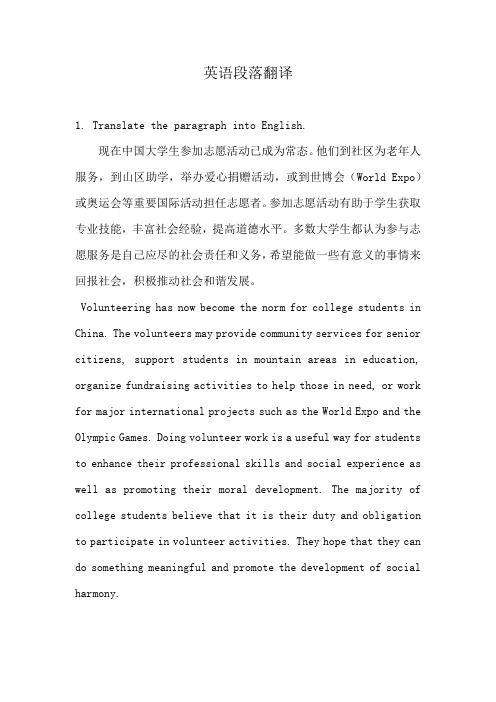
英语段落翻译1. Translate the paragraph into English.现在中国大学生参加志愿活动已成为常态。
他们到社区为老年人服务,到山区助学,举办爱心捐赠活动,或到世博会(World Expo)或奥运会等重要国际活动担任志愿者。
参加志愿活动有助于学生获取专业技能,丰富社会经验,提高道德水平。
多数大学生都认为参与志愿服务是自己应尽的社会责任和义务,希望能做一些有意义的事情来回报社会,积极推动社会和谐发展。
Volunteering has now become the norm for college students in China. The volunteers may provide community services for senior citizens, support students in mountain areas in education, organize fundraising activities to help those in need, or work for major international projects such as the World Expo and the Olympic Games. Doing volunteer work is a useful way for students to enhance their professional skills and social experience as well as promoting their moral development. The majority of college students believe that it is their duty and obligation to participate in volunteer activities. They hope that they can do something meaningful and promote the development of social harmony.2. Translate the paragraph into English.自2008年全面实行免费开放以来,中国博物馆每年举办展览两万多个,年参观人次达6亿多。
[新教材]课时分层作业5 《老子》四章 五石之瓠—2020年秋统编版(2019)选择性必修上册
![[新教材]课时分层作业5 《老子》四章 五石之瓠—2020年秋统编版(2019)选择性必修上册](https://img.taocdn.com/s3/m/a718ee99f111f18582d05a55.png)
课时分层作业(五)[基础运用层]1.下列句子中没有通假字的一项是()A.九层之台,起于累土B.其未兆易谋C.宋人有善为不龟手之药者D.我世世为洴澼B[A项,“累”同“蔂”,土筐;C项,“龟”,通“皲”,皮肤冻裂;D 项,“”,同“纩”,丝绵絮。
]2.下列语句中加点的词,解释不正确的一项是()A.我树.之成而实五石树:栽种B.能不龟手一.也一:一样C.凿户牖以为室,当.其无当:当作D.埏埴.以为器,当其无埴:黏土C[C项,当:有、只有。
]3.对下列加点词的意义和用法的解释,不正确的一项是()A.当.其无,有器之用当:连词,只有B.共一毂,当其.无,有车之用其:代词,它C.跨者.不行,自见者不明者:助词,……的(人)D.民之从事,常于几成而.败之而:连词,表修饰D[D项,连词,表示转折关系,可译为“却”。
]4.下列对原文有关内容的分析和概括,不正确的一项是()A.老子特地提醒人们要全面地看待事物,指出事物是由“有”“无”两者结合而成,从而可以“利”和“用”。
B.《老子》认为,自以为是的人,虽是要彰显自己,却往往不能彰显自己;自我夸耀的人,虽是显示自己的功劳,却往往不被认为有功或者不能成就大功。
C.“知人者智,自知者明。
胜人者有力,自胜者强。
”《老子》认为“自知”比“知人”更加重要,“胜人”比“自胜”更加难得。
这是极富人生哲理的判断。
D.人们做事,常常是在将要成功的时候却让它失败了。
假如将要完成的时候像开始的时候一样谨慎,就不会败坏事情了。
《老子》告诫人们做事要善始善终。
C[C项,应为:“自胜”比“胜人”更加难得。
]5.给下面的文字加上标点。
企者不立跨者不行自见者不明自是者不彰自伐者无功自矜者不长答案:企者不立,跨者不行,自见者不明,自是者不彰,自伐者无功,自矜者不长。
6.把下列句子翻译成现代汉语。
(1)其在道也,曰余食赘行,物或恶之,故有道者不处。
译文:__________________________________________________(2)知人者智,自知者明。
课时作业5:文言语句翻译
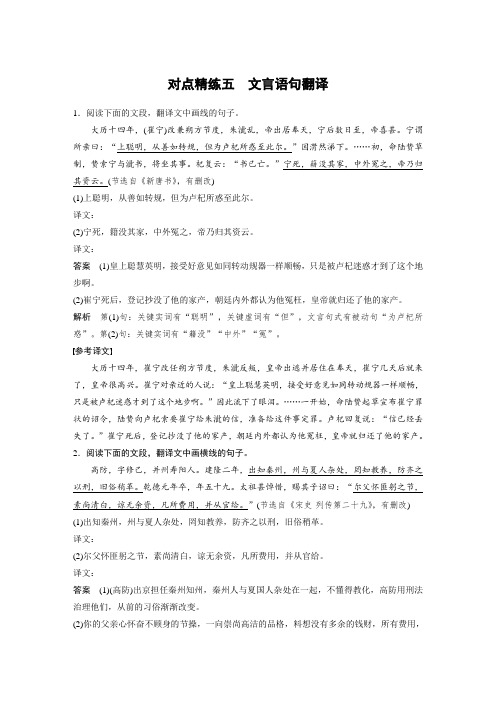
对点精练五文言语句翻译1.阅读下面的文段,翻译文中画线的句子。
大历十四年,(崔宁)改兼朔方节度,朱泚乱,帝出居奉天,宁后数日至,帝喜甚。
宁谓所亲曰:“上聪明,从善如转规,但为卢杞所惑至此尔。
”因潸然涕下。
……初,命陆贽草制,贽索宁与泚书,将坐其事。
杞复云:“书已亡。
”宁死,籍没其家,中外冤之,帝乃归其资云。
(节选自《新唐书》,有删改)(1)上聪明,从善如转规,但为卢杞所惑至此尔。
译文:________________________________________________________________________ (2)宁死,籍没其家,中外冤之,帝乃归其资云。
译文:________________________________________________________________________答案(1)皇上聪慧英明,接受好意见如同转动规器一样顺畅,只是被卢杞迷惑才到了这个地步啊。
(2)崔宁死后,登记抄没了他的家产,朝廷内外都认为他冤枉,皇帝就归还了他的家产。
解析第(1)句:关键实词有“聪明”,关键虚词有“但”,文言句式有被动句“为卢杞所惑”。
第(2)句:关键实词有“籍没”“中外”“冤”。
参考译文大历十四年,崔宁改任朔方节度,朱泚反叛,皇帝出逃并居住在奉天,崔宁几天后就来了,皇帝很高兴。
崔宁对亲近的人说:“皇上聪慧英明,接受好意见如同转动规器一样顺畅,只是被卢杞迷惑才到了这个地步啊。
”因此流下了眼泪。
……一开始,命陆贽起草宣布崔宁罪状的诏令,陆贽向卢杞索要崔宁给朱泚的信,准备给这件事定罪。
卢杞回复说:“信已经丢失了。
”崔宁死后,登记抄没了他的家产,朝廷内外都认为他冤枉,皇帝就归还了他的家产。
2.阅读下面的文段,翻译文中画横线的句子。
高防,字修己,并州寿阳人。
建隆二年,出知秦州,州与夏人杂处,罔知教养,防齐之以刑,旧俗稍革。
乾德元年卒,年五十九。
太祖甚悼惜,赐其子诏曰:“尔父怀匪躬之节,素尚清白,谅无余资,凡所费用,并从官给。
英语默写试题及答案
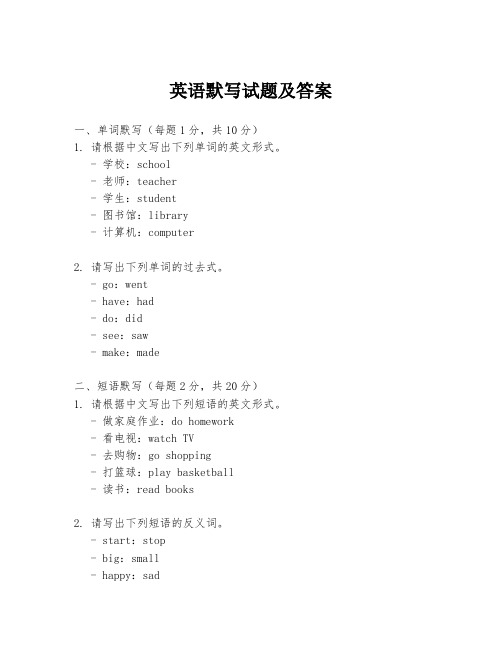
英语默写试题及答案一、单词默写(每题1分,共10分)1. 请根据中文写出下列单词的英文形式。
- 学校:school- 老师:teacher- 学生:student- 图书馆:library- 计算机:computer2. 请写出下列单词的过去式。
- go:went- have:had- do:did- see:saw- make:made二、短语默写(每题2分,共20分)1. 请根据中文写出下列短语的英文形式。
- 做家庭作业:do homework- 看电视:watch TV- 去购物:go shopping- 打篮球:play basketball- 读书:read books2. 请写出下列短语的反义词。
- start:stop- big:small- happy:sad- fast:slow- young:old三、句子默写(每题5分,共30分)1. 请根据中文写出下列句子的英文形式。
- 我每天早晨7点起床。
— I get up at 7 o'clock every morning.- 她喜欢在周末去公园。
— She likes to go to the park on weekends.- 他们正在学习英语。
— They are studying English.- 他昨天去了图书馆。
— He went to the library yesterday.- 我们计划明天去看电影。
— We are planning to watch a movie tomorrow.2. 请将下列句子翻译成中文。
- The cat is under the table.—猫在桌子下面。
- She is reading a book in the library.—她在图书馆里读书。
- They are playing football in the park.—他们在公园里踢足球。
- He will go to the concert tonight.—他今晚将去音乐会。
汉译英段落5及参考译文
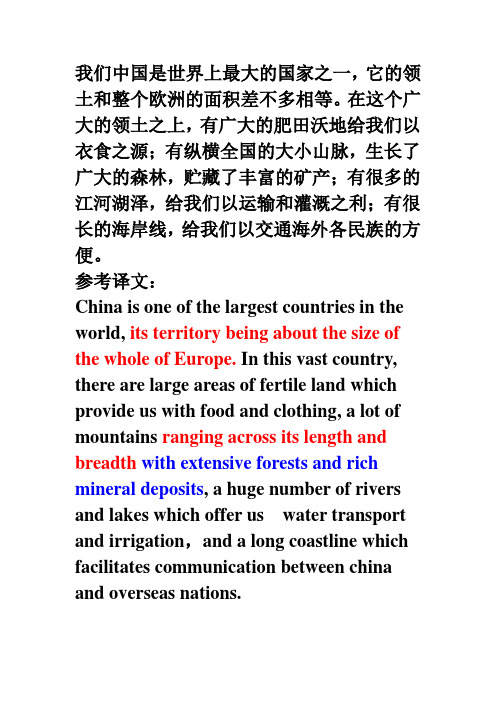
我们中国是世界上最大的国家之一,它的领土和整个欧洲的面积差不多相等。
在这个广大的领土之上,有广大的肥田沃地给我们以衣食之源;有纵横全国的大小山脉,生长了广大的森林,贮藏了丰富的矿产;有很多的江河湖泽,给我们以运输和灌溉之利;有很长的海岸线,给我们以交通海外各民族的方便。
参考译文:
China is one of the largest countries in the world, its territory being about the size of the whole of Europe. In this vast country, there are large areas of fertile land which provide us with food and clothing, a lot of mountains ranging across its length and breadth with extensive forests and rich mineral deposits, a huge number of rivers and lakes which offer us water transport and irrigation,and a long coastline which facilitates communication between china and overseas nations.。
英译汉将下列句子翻译成汉语(精)

英译汉将下列句子翻译成汉语(精)英译汉:将下列句子翻译成汉语1. The Meeting Rooms are on the ground floor.会议室在一楼。
2. He's talking to a customer right now. 他现在正在和一个顾客交谈。
3. David usually have a sandwich in his office at lunchtime.午饭时间大卫通常在办公室吃三明治。
4. I have a reservation for a single room.我预订了一间单人房。
5. I'm waiting for an important telephone call from my boss in Shanghai.我在等上海老板的一个重要电话。
6. The living room is large and comfortable.客厅宽敞而舒适。
7. I prefer watching TV to reading the paper.和看报纸相比,我更喜欢看电视。
8. The bank is opposite the newsagent’s. 银行在报刊亭对面。
9. He borrows a lot of money from me.他向我借了很多钱。
10. It takes forty minutes to get from the airport to the city center by taxi.从机场到市中心乘出租车要四十分钟。
11. You need to reduce your temperature.你需要退烧。
12. I feel worried about my exam next week.我担心下个星期的考试。
13. He is good at web-design, much better than her.他擅长网页设计,比她好的多。
- 1、下载文档前请自行甄别文档内容的完整性,平台不提供额外的编辑、内容补充、找答案等附加服务。
- 2、"仅部分预览"的文档,不可在线预览部分如存在完整性等问题,可反馈申请退款(可完整预览的文档不适用该条件!)。
- 3、如文档侵犯您的权益,请联系客服反馈,我们会尽快为您处理(人工客服工作时间:9:00-18:30)。
他们没有认识到他们所面临的一些问题的困难度。在1974年,为回应英国James Lighthill爵士的批评和由国会要求建立更多卓有成效的工程带来的不断 增加的压力,美国和英国政府取缔了人工智能方向所有的没有明确应用指向的、探究性的研究。由于研究工程的支持基金难以寻求,接下来的几年后 来被称为“人工智能萧条期”。
了20世纪70年代中期,美国的人工智能研究被国防部,世界各地也建立了实验室。对于人工智能的未来,其创立者们极度乐观:Herbert 言“20年之内,机器将能完成任何人类能做的工作”, 质上的解决”。
Simon预
Marvin Minsky表示赞同,写到“用不了一代人的时间,创造“人工智能”的问题将会得到本
在20世纪末和21世纪初,人工智能获得了空前成功。人工智能被用在运筹学、数据挖掘、医疗诊断和其他许多工业技术领域。这一成功归 功于以下几个因素:当今电脑的惊人功能,更强调解决具体问题,建立了人工智和其他解决相似问题的领域之间的联系,除此之外,还 有研究者们对坚实数学方法和严谨科学标准的的努力。
在20世纪90年代早期,人工智能研究随着专家系统在商业上的成功而复苏。专家系统是模仿一个或更多人类专家知识和分析技巧的人工智能程序。截 止到1985年,人工智能的市场份额已经超过了十亿美元。同时,日本的第五代计算机工程鼓舞了美国和英国政府恢复对人工智能领域学术研究的资金 支持。但是,以1987年Lisp机市场崩溃为开端,人工智能再次招致恶名,陷入了一个更长的萧条期。
They had failed to recognize the difficulty of some of the problems they faced. In 1974, in response to the criticism of England's Sir James Lighthill and ongoing pressure from Congress to fund more productive projects, the U.S. and British governments cut off all undirected, exploratory research in AI. The next few years, when funding for projects was hard to find, would later be called an "AI winter".
人工智能领域的研究奠基于1956年Dartmouth大学的一次校园内部会议。与会者有John McCarthy, Marvin Minsky, Allen Newell 和Herbert Simon,这些
人在后来数十年中成为人工智能领域的领军人物。他们和学生编写了令人惊讶的程序:令电脑可以求解代数应用题,证明逻辑理论,还能说英语。到
作业五:将下列段落翻译成中文
History of Artificial Intelligence
人工智能的历史
The field of Artificial Intelligence (AI) research was founded at a conference on the campus of Dartmouth College in the summer of 1956. The attendees, including John McCarthy, Marvin Minsky, Allen Newell and Herbert Simon, became the leaders of AI research for many decades. They and their students wrote programs that were, to most people, simply astonishing: computers were solving word problems in algebra, proving logical theorems and speaking English. By the middle of the 1960s, research in the U.S. was heavily funded by the Department of Defense and laboratories had been established around the world. AI's founders were profoundly optimistic about the future of the new field: Herbert Simon predicted that "machines will be capable, within twenty years, of doing any work a man can do" and Marvin Minsky agreed, writing that "within a generation ... the problem of creating 'artificial intelligence' will substantially be solved".
In the 1990s and early 21st century, AI achieved its greatest successes. Artificial intelligence is used for logistics, data mining, medical diagnosis and many other areas throughout the technology industry. The success was due to several factors: the incredible power of computers today, a greater emphasis on solving specific subproblems, the creation of new ties between AI and other fields working on similar problems, and above all a new commitment by researchers to solid mathematical methods and rigorous scientific standards.
